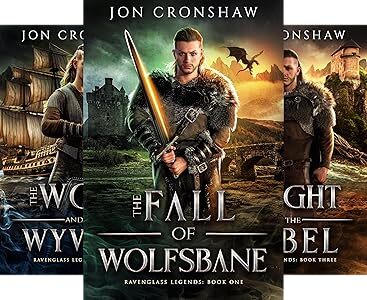Fantasy World-Building: The Power of History and Memory
In fantasy literature, history isn’t just a backdrop—it’s a living, breathing entity that shapes characters, drives conflicts, and adds depth to imaginary worlds.
Today, we’ll explore how history and memory function in fantasy, using the legacy of Meerand from my Ravenglass Legends series as our guide.
The Weight of the PastIn “The Fall of Wolfsbane”, the history of Meerand isn’t just a collection of dry facts.
It’s a force that profoundly influences our protagonists, Ragnar and Maja Wolfsbane.
The fall of their homeland serves as both a personal tragedy and a catalyst for their individual journeys.
Ragnar’s memories of Meerand’s warrior culture shape his identity, even as he’s forced to adapt to life in the Ostreich Empire.
Meanwhile, Maja’s recollections of her homeland fuel her resistance against the Empire’s attempts to ‘civilise’ her.
In both cases, we see how personal and cultural memories can act as anchors in a changing world.
History as ConflictThe conquest of Meerand by the Ostreich Empire illustrates how history often serves as the root of conflict in fantasy worlds.
The clash between Meerand’s clan-based society and the Empire’s ‘civilising’ mission creates tension that drives much of the story.
This conflict isn’t just about territory.
It’s a battle between differing worldviews, each shaped by its own history.
The Empire sees itself as a force of progress, while the people of Meerand view it as a destroyer of tradition.
This dynamic mirrors real-world colonial conflicts, adding depth and relevance to our fantasy narrative.
The Unreliability of HistoryOne fascinating aspect of using history in fantasy is the opportunity to explore how stories change over time.
In “The Fall of Wolfsbane”, we see how the Empire’s version of events differs from the memories of those from Meerand.
This discrepancy raises interesting questions.
Who gets to write history?
How do victors shape the narrative?
How do the conquered keep their stories alive?
By presenting multiple perspectives, we create a richer, more nuanced world that challenges readers to think critically about the nature of historical truth.
Cultural Memory and IdentityThe legacy of Meerand isn’t just about past events—it’s a crucial part of our characters’ cultural identity.
Ragnar and Maja’s struggles to maintain their connection to their heritage while navigating a new world reflect the real-world challenges faced by displaced peoples.
Through their experiences, we explore how cultural memory can be both a source of strength and a burden.
It provides a sense of identity and belonging, but can also create barriers to adaptation and understanding.
Legends and MythsIn many fantasy worlds, including that of the Ravenglass Legends, historical events often take on mythic proportions.
The story of Meerand’s fall, the tales of past Wolfsbane chieftains, and the legends surrounding ravenglass all contribute to a rich tapestry of lore.
These in-world myths and legends serve multiple purposes.
They add depth to the world, provide motivation for characters, and often foreshadow future events.
They also allow us to explore how stories evolve over time, taking on new meanings for new generations.
History as World-BuildingFrom a craft perspective, using history and memory is a powerful tool for world-building.
The legacy of Meerand helps to create a sense of depth and realism in our fantasy world.
It suggests a world that existed long before our story began and will continue long after it ends.
By referencing past events, hinting at ancient conflicts, and showing how different cultures interpret shared history, we create a world that feels lived-in and authentic.
This depth invites readers to immerse themselves fully in the story.
The Future Shaped by the PastFinally, it’s worth noting how the legacy of Meerand doesn’t just inform the present in “The Fall of Wolfsbane”.
It also shapes the future.
Ragnar and Maja’s actions, driven by their memories and cultural heritage, have the potential to change the course of their world’s history.
This interplay between past, present, and future creates a dynamic narrative where history isn’t just a static backdrop, but an active force in the story.
The Power of MemoryThe legacy of Meerand in “The Fall of Wolfsbane” demonstrates the power of history and memory in fantasy world-building.
It shapes characters, drives conflicts, adds depth to the world, and provides a rich foundation for storytelling.
By engaging with themes of history and memory, fantasy doesn’t just offer escapism.
It provides a lens through which we can explore complex ideas about identity, culture, and the stories we tell about ourselves.
How do you think the use of history and memory enhances fantasy storytelling?
Share your thoughts in the comments below!
 start reading The Fall of Wolfsbane.
start reading The Fall of Wolfsbane.The post Fantasy World-Building: The Power of History and Memory first appeared on Jon Cronshaw.



